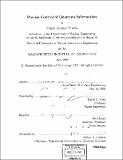Precise control of quantum information
Author(s)
Pravia, Marco Antonio (Pravia Hernandez), 1975-
DownloadFull printable version (4.754Mb)
Other Contributors
Massachusetts Institute of Technology. Dept. of Nuclear Engineering.
Advisor
David G. Cory.
Terms of use
Metadata
Show full item recordAbstract
Theoretical discoveries in the nascent field of quantum information processing hold great promise, suggesting the means for increased computational power and unconditionally secure communications. To achieve these advances in practice, however, quantum information must be stored and manipulated with high fidelity. Here, we describe how quantum information stored in a nuclear spin system can be controlled accurately. We describe a method creating strongly-modulating single-spin gates that faithfully produce the desired unitary transformations. The simulated fidelity of the best gate (under ideal conditions) reaches close to 0.99999, a value close to estimates of the fault-tolerant threshold. In addition, we show how knowledge of experimental errors can be used correct or compensate the gates. The experimental demonstration of these methods yields estimated single-spin and coupling gate fidelities close to 0.99. The methods are applicable to a variety of experimental studies in quantum information processing. We used the gates to implement strategies for combating decoherence, including the realization of a noiseless subsystem and the concatenation of quantum error correction with dynamical decoupling. The gates were also used to demonstrate the quantum Fourier transform, the disentanglement eraser, and an entanglement swap. Finally, we describe a nuclear magnetic resonance (NMR) implementation of a quantum lattice gas (QLG) algorithm. Recently, it has been suggested that an array of small quantum information processors sharing classical information can be used to solve selected computational problems. The concrete implementation demonstrated here solves the diffusion equation, and it provides a test example from which to (cont.) probe the strengths and limitations of this new computation paradigm. The NMR experiment consists of encoding a mass density onto an array of 16 two-qubit quantum information processors and then following the computation through 7 time steps of the algorithm. The results show good agreement with the analytic solution for diffusive dynamics.
Description
Thesis (Ph. D.)--Massachusetts Institute of Technology, Dept. of Nuclear Engineering, 2002. Includes bibliographical references (p. 93-101).
Date issued
2002Department
Massachusetts Institute of Technology. Department of Nuclear Engineering; Massachusetts Institute of Technology. Department of Nuclear Science and EngineeringPublisher
Massachusetts Institute of Technology
Keywords
Nuclear Engineering.